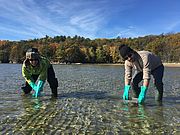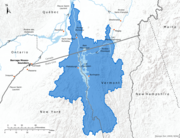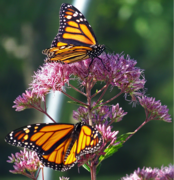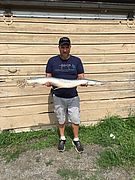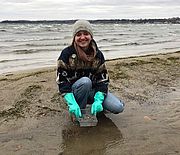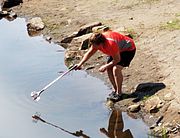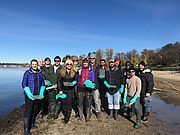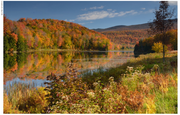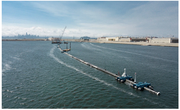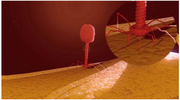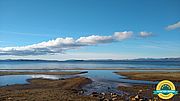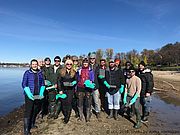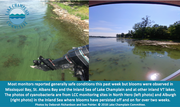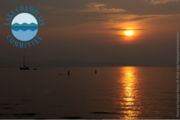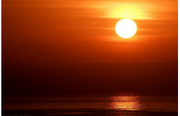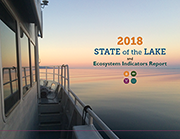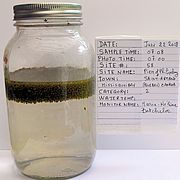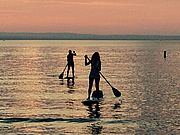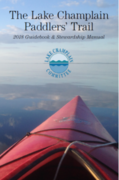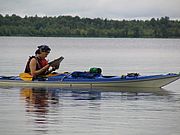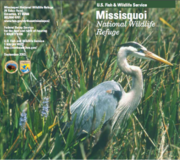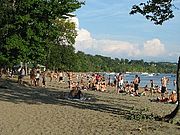It was a sunny, crisp October morning. The rainy grey mist from the week before had cleared to reveal a stunning panorama of mountains, lake, and sand. On a beach just north of Burlington LCC staff and volunteers and a crew from Magic Hat Brewery, bundled in warm layers against the morning chill, arranged in a staggered line. Those with muck boots waded through the shallow water, while the others walked along the shoreline. Every few paces each stopped to kneel and scoop up sand in a small metal sieve. They then shook away the sand, as if panning for gold, examined the contents briefly – and discarded them.
News from Selected Month
Interested in Lake Champlain’s past, present and future? Sign up soon to join LCC at The Lake Between (Le lac qui nous unit) – an International Conference designed to bring together academics, business leaders, policy-makers, outdoor enthusiasts, boaters and swimmers, musicians and artists to talk about the lake.
The Nature note below is written by Laura Pratt, LCC’s new ECO AmeriCorps Education & Outreach Coordinator. Monarchs left the Lake Champlain watershed in September as temperatures dropped and the milkweed died back. Both factors drive their migration as they can’t survive low temperatures or reproduce without milkweed. Their destination? The oyamel fir forests north of Mexico City where all monarchs east of the Rocky Mountains migrate for winter. The butterflies that survived the journey from the Champlain Valley should be arriving in Mexico throughout November.
On August 18 of this year, a man fishing for channel catfish in Lake Champlain’s South Bay reeled in a record-breaking longnose gar instead. The big fish was 52 and ¼ inches long and weighed in at 14 pounds 10 ounces, besting the 1999 New York state record by one and a half pounds.
Laura Pratt is LCC’s newest ECO AmeriCorps Education & Outreach Coordinator. She joined LCC in September and picks up on the service of Dominic Brennan and Daniel Denora who preceded her in the eleven-month position.
Deep thanks to all our cyanobacteria monitors for their diligent work during the 2018 season. Many began assessing site conditions in mid-June and filed their final report 19 weeks later in mid-October. LCC monitors and our partners at the Vermont and New York Departments of Health and Environmental Conservation gathered data from nearly 150 sites in the Lake Champlain watershed and filed more than 1,800 reports about water conditions.
For several years, Magic Hat Brewing Company has been funding LCC programs, promoting our work for clean water with special lake brews, and providing volunteer assistance for special projects. Our latest collaboration was a two-day session to search for Asian clams, an invasive mollusk that’s been found in nearby waterways.
WCAX TV - "A shorebird with an intense appetite and destructive droppings is on the decline in Lake Champlain. A multi-year effort by Vermont Fish and Wildlife, the New York DEC, and private land owners to reduce the cormorant population appears to be paying off."
The Trust for Public Land - "The Trust for Public Land conducted an economic analysis and found that every $1 invested in land conservation by the state returns $9 in economic value in natural goods and services, such as water quality protection, flood mitigation, and food production, to the Vermont economy."
The New York Times - "A multimillion-dollar floating boom designed to corral plastic debris littering the Pacific Ocean deployed from San Francisco Bay on Saturday as part of a larger high-stakes and ambitious undertaking."
Water World - "To rapidly detect the presence of E. coli in drinking water, Cornell University food scientists now can employ a bacteriophage - -a genetically engineered virus -- in a test used in hard-to-reach areas around the world."
Today is GivingTuesday, the "Black Friday" for charitable giving and part of an international movement to create a day of giving back. Please consider participating by making a gift of time or money to the Lake Champlain Committee.
It was a sunny, crisp October morning. The rainy grey mist from the week before had cleared to reveal a stunning panorama of mountains, lake, and sand. On a beach just north of Burlington a group of volunteers, bundled in warm layers against the morning chill, were ranged in a staggered line. Those with muck boots waded through the shallow water, while the others walked along the shoreline. Every few paces each stopped to kneel and scoop up sand in a small steel sieve. They then shook away the sand, as if panning for gold, examined the contents briefly – and discarded them.
The 2018 cyanobacteria monitoring season has come to a close! Read the final report of 2018 to see the season statistics, learn about recent lake phenomena and find ways to stay involved until next year! Thank you to everyone who helped make this another successful monitoring season!
Despite cooler, windy weather, blooms still showed up in parts of Lake Champlain and Lake Memphremagog during the week. While cooler temperatures may cause blooms to dissipate, the same weather can stimulate blooms in other lakes.
Blooms showed up in the Inland Sea, Main Lake Central, St. Albans Bay and Missisquoi Bay sections of Lake Champlain and several inland lakes this week. Cooler, windy weather blew into the region late in the week providing a welcome change in temperature.
Blooms showed up in many sections of Lake Champlain and at inland lakes as well, keeping monitors busy. Sincere thanks for the diligent reporting and a special shout out to interested citizens who took the time to do some online training about cyanobacteria and report in about conditions observed. We greatly appreciate your efforts!
Monitors reported generally safe conditions from most Lake Champlain and inland waterways during the past week, however blooms were observed in St. Albans Bay, the Inland Sea and Missisquoi Bay and on several smaller waterways. While many people think of cyanobacteria blooms as a summer phenomenon, they can also persist in the fall. In fact, this weekend’s cooler temperatures may trigger turn over in some of our smaller lakes and ponds.
Read about recent water news in the Champlain Basin and find out about upcoming events in the Summer's Wane E-news!
It’s been another busy week of monitoring with 121 reports filed for Lake Champlain and inland lake locations. While good conditions persisted at most locations, blooms did show up on some inland lakes and on all sections of Lake Champlain except for the South Lake. Please be mindful that conditions can change rapidly.
From July 18 to August 16, a stretch of 29 days, the daily high temperature in Burlington, Vermont never fell below 80 degrees F. The streak eclipsed the previous record for consecutive days over 80 by four days. Keep in mind, the streak of hot days began AFTER temperatures climbed into the 90s for six straight days earlier in July. During that heat streak the region set another record, the highest ever daily low temperature of 80 degrees.
“This report helps the public to interpret information about the Lake using the best scientific data available. Lake managers use this information to develop and assess strategies for improving water quality in Lake Champlain,” said Dr. Eric Howe, LCBP Director. “In the 2018 report, we provide updated information on the many issues facing Lake Champlain.”
Hats off to the great group of dedicated cyanobacteria monitoring volunteers who are reporting on water quality from over 100 Lake Champlain shoreline locations and inland lakes. LCC has trained nearly 300 individuals this season to identify cyanobacteria, including state and municipal recreational staff and water treatment system operators.
Stay up to date on water conditions on Lake Champlain and inland lakes with LCC’s weekly cyanobacteria reports. The report compiles and summarizes data collected from over 100 LCC monitoring sites in New York, Vermont and Quebec. It also includes helpful information on how to recognize and report cyanobacteria and actions to take to reduce bloom frequency.
A 2013 report identified stand-up paddling as the outdoor sport with the most first-time participants in the United States that year. Though variations of stand-up paddling have been around for centuries, the current craze began in the early 2000’s. At that time, Hawaiian surfers brought the sport to California. Stand-up paddling proved to be an easier entry point for novices to the surfing world and rapidly grew in popularity, spreading throughout the country and to inland waters like Lake Champlain.
Late summer and early fall can be wonderful times on the water. Make the most out of them with the 2018 edition of the Lake Champlain Paddlers' Trail guidebook. It’s jam-packed with helpful information for great lake adventures, including site descriptions and chartlets for more than 40 Trail locations (with access to over 600 campsites), launch site listings, natural history articles, safety and stewardship tips, equipment check lists, and more!
Boating on the lake can be a wonderful experience if you are well prepared and use common sense. Changing weather, variable water conditions, and other activity on the lake can affect your safety and enjoyment. Please follow these guidelines while traveling on the Trail.
Situated on Lake Champlain, the Missisquoi National Wildlife Refuge is nationally recognized for its biological diversity and high quality wetlands. Established in 1943 to provide habitat for migratory birds, it consists of nearly 7,000 acres of refuge for avian creatures and other wildlife.
Sand and waves, suntan lotion, bathing suits, a child’s plastic pail and shovel for building castles. Spending a day at the beach is a long standing summer tradition, but did you ever wonder why there aren’t more beaches? Why do beaches form along some coves on Lake Champlain but not others?
Adirondack Explorer - Located less than 2 miles upstream of Ausable Forks, the Jay Town Board voted in March of 2017 to remove the dam after an engineering study found that it posed a threat to residents downstream because of its potential to fail.

